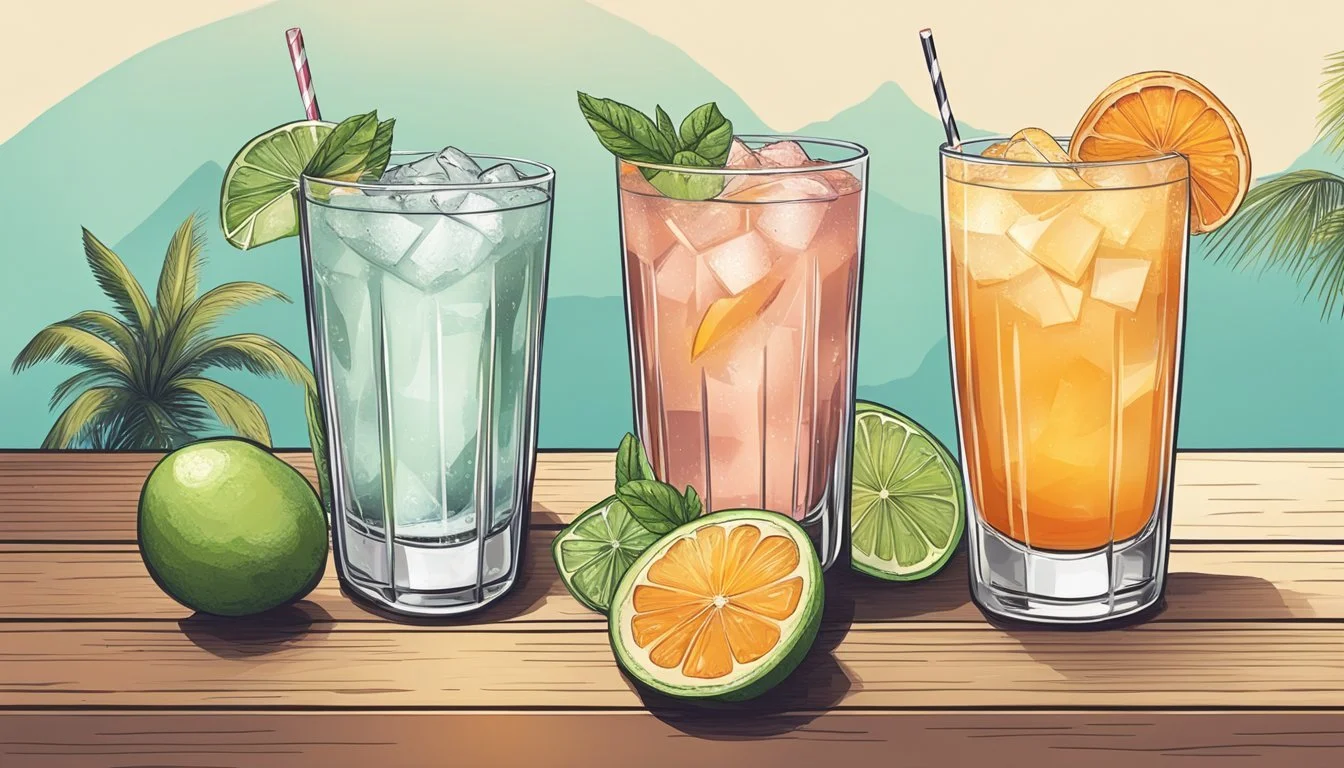The History of the Paloma Cocktail
Tracing Its Origins and Popularity
The Paloma cocktail, a refreshing blend of tequila and grapefruit soda, has become a staple in the pantheon of classic drinks. Its simplicity belies a rich tradition that places it as a favorite not only in its country of origin, Mexico, but globally. Although the precise origins of the Paloma are not definitively traced, it is widely recognized as a beloved staple in Mexican culture. The drink's composition is straightforward: tequila, a fizzy grapefruit-flavored soda, and a squeeze of lime juice, served on the rocks with an optional salted rim.
Mexican tequila and the effervescence of grapefruit soda marry in the glass to create a balance of sweet, tart, and salty flavors that have captured the palates of countless enthusiasts. Unlike some cocktails that are surrounded by vivid origin stories, the Paloma's creation is shrouded in mystery, with various accounts and anecdotes but little concrete evidence pointing to its inception. It’s often mentioned in the same breath as other tequila-based libations, yet stands out due to its unassuming charm and easy drinkability.
Mexico, known for its rich spirits tradition, lays claim to the Paloma as one of its unofficial national drinks. Its widespread popularity extends beyond borders, transcending cultures and finding a place in bars and homes around the world. The introduction of Squirt soda, a common mixer for the Paloma, around the mid-20th century contributed to the cocktail's diffusion, ultimately reinforcing its status as a timeless crowd-pleaser.
Origins and History
The Paloma cocktail is a venerable Mexican concoction, whose beginnings are intertwined with the nation's cultural and culinary history. This section details its inception, rise to popularity, and key personalities involved in its storied past.
Inception in Mexico
The Paloma, meaning 'dove' in Spanish, is believed to have originated in Mexico. The key components of this refreshing cocktail are blanco tequila and grapefruit soda. A notable detail is its connection to the introduction of Squirt, a grapefruit-flavored soda, into the Mexican market around 1955, which played a significant role in the Paloma's formulation.
Popularity and Evolution
Over the decades, the Paloma has evolved both in its recipe and its reach. With Evan Harrison's promotion of the cocktail in his 1953 booklet, "A Cook’s Tour of Mexico," the drink gained traction. It is now widely regarded as a staple in Mexican culture, often preferred even over the margarita in its native land.
Notable Figures
One cannot discuss the Paloma without mentioning Don Javier Delgado Corona, the legendary bartender from La Capilla in Tequila, Mexico. His contributions to the cocktail's history and its propagation have cemented both his and La Capilla's place in cocktail lore. While no single creator is credited with the invention of the Paloma, Don Javier's impact on the craft of Mexican cocktails is undisputed.
The Classic Recipe
The Paloma is a cocktail that traditionally combines tequila with grapefruit flavors, balanced by lime. This section outlines the key ingredients, preparation method, and garnishing techniques to craft this classic drink.
Key Ingredients
Tequila: 1 to 3 ounces, with reposado type preferred for its smooth, aged characteristics.
Grapefruit Soda: 3 parts, serving as the sweet and tart effervescent component of the drink.
Lime Juice: Freshly squeezed, adding a zesty note.
Preparation Method
Fill a highball glass with ice.
Pour in the tequila.
Add freshly squeezed lime juice.
Top off with grapefruit soda.
Stir gently to combine the flavors.
Garnishing Techniques
Salt: Lightly rim the glass with salt, enhancing the cocktail's taste profile.
Lime Wedge: A slice or wedge of lime on the rim for aesthetics and a finishing touch of citrus.
Cultural Significance
The Paloma cocktail enjoys significant cultural importance within Mexico and beyond, symbolizing a refreshing link between traditional Mexican flavors and international cocktail culture.
National and International Reach
In Mexico, the Paloma is not just a cocktail; it's a national treasure. Often more popular than the margarita, the Paloma—Spanish for "the dove"—is ubiquitous in bars and households, especially during the summer months when its refreshing qualities are particularly appreciated. A simple mixture of tequila and grapefruit soda commonly found in a Mexican cookbook, the Paloma has crossed borders to gain popularity in places like Texas, where the drink's refreshing nature complements the warm climate.
Mexico: National staple in bars and homes
Texas: Popular due to its refreshing qualities in warm climates
International Recognition:
It has been incorporated into the list of popular cocktails in regions alongside the Rio Grande, demonstrating its international reach. The Paloma has become emblematic of Mexico's vibrant spirit and cocktail innovation, often celebrated in various global cocktail competitions and menus worldwide.
Appearance in Literature and Media
The Paloma's embodiment of Mexican culture has found its way into literature and media, solidifying its role beyond just being a drink. Its mention in stories and shows not only adds a touch of authentic Mexican culture but also demonstrates the drink's integration into the fabric of culinary narratives. The Paloma has been spotlighted in various media as a symbol of Mexico's rich heritage, often linked to festivities and traditional events within the country.
Media Presence:
Portrayed in television and film: As a cultural icon
Featured in literary works: Representing Mexican tradition and celebration
Through its consistent appearance, the Paloma cocktail maintains its status as a treasured symbol of the convivial spirit that is synonymous with Mexican festivities and relaxation anywhere in the world.
Variations and Innovations
The journey of the Paloma cocktail through time has seen a myriad of variations and innovations, with bartenders experimenting with different ingredients and techniques to put a unique spin on this classic drink.
Alternative Ingredients
Soda Choices: While Squirt soda remains a classic mixer for the Paloma cocktail, bartenders have been exploring other carbonated options. Sparkling water infused with fresh grapefruit juice offers a less sweet but equally refreshing alternative. Mixologists also sometimes incorporate grapefruit bitters into the mix for a more complex flavor profile.
Spirits Used: Blanco tequila is the traditional spirit for Paloma cocktails, but other types of tequila, such as reposado tequila, are often used for a more nuanced taste. Moreover, variations with mezcal offer a smokier version. Some bartenders reach beyond the tequila shelf, using gin or rum to craft a different but still recognizable iteration of the Paloma.
Specialty Paloma Cocktails
Creation and Modifications: Specialized versions of the Paloma have emerged on many menus. For instance, the Spicy Paloma adds a kick, frequently achieved by incorporating jalapeño or chili-infused agave syrup, appealing to those seeking a more piquant taste experience.
Service and Presentation: While historically casual in its service, the Paloma has seen a transformation in some establishments, where it is served in highball glasses with meticulously garnished rims and decorative elements to elevate the drinking experience, aligning it with the meticulous presentation of tequila cocktails such as the Batanga or the classic Rum and Coke.
Serving and Presentation
The Paloma cocktail, with its balance of sweet and sour flavors, is traditionally served on the rocks, offering a refreshing experience ideally suited for beach outings or casual dining at restaurants.
Glassware and Presentation
The preferred glassware for a Paloma is a highball glass, enhancing both the visual and taste experience.
Glass Type: Highball glass
Preparation: Salt the rim
Ice: Cubed, fill the glass
Garnish: Lime wedge or wheel
Pairings and Occasions
Palomas are versatile and pair well with a variety of foods and settings.
Food Pairings:
Spicy dishes: Balances heat with its sweet and sour profile
Seafood: Complements with a crisp, citrusy taste
Occasions:
Beach gatherings: Its refreshing nature is well-suited for a sunny day
Casual dining: Offered in restaurants as a staple accompaniment to a range of meals
Comparisons With Other Cocktails
The rich history of the Paloma cocktail offers insightful comparisons with other mixed drinks, particularly in ingredients, preparations, and cultural impact.
The Paloma vs. Margarita
Ingredients: Both the Paloma and the Margarita feature tequila as the primary spirit. The Margarita combines tequila with lime juice and an orange liqueur, traditionally triple sec, while the Paloma pairs tequila with fresh grapefruit, often in the form of soda.
Popularity: The Margarita is globally renowned and often associated with Mexican cuisine. Meanwhile, the Paloma, despite being a staple in Mexico, has gained recognition through the endorsement of figures like David Wondrich, who praises its simplicity.
Other Tequila-Based Cocktails
Variety: The Paloma distinguishes itself among tequila cocktails by its use of grapefruit. Other popular tequila concoctions, such as the Tequila Sunrise or the Batanga—a cocktail from the Tlaquepaque restaurant, which combines tequila with cola—use different mixers to create distinct flavor profiles.
Method: Like the Paloma, many tequila cocktails employ a similar straightforward approach to mixing, favoring fresh ingredients and minimalistic techniques that highlight the tequila's characteristics.
Similar Two-Ingredient Highballs
Simplicity: The Paloma belongs to a family of two-ingredient highballs revered for their ease of preparation. These highballs typically blend a spirit with a carbonated beverage, such as a gin and tonic or whiskey and ginger ale.
Versatility: While the Paloma uses grapefruit soda, exploring variations with other sodas or fresh grapefruit juice allows for customizability without compromising the integrity of the original cocktail, echoing the adaptability seen in other two-ingredient highballs.
Modern Reception
The Paloma cocktail has witnessed a notable resurgence in popularity, influenced by consumer demand for refreshing and balanced drinks that showcase a harmonious blend of flavors.
Current Trends in Bars
In contemporary bars, the Paloma is often celebrated for its simplicity and versatility. Bartenders are not just reaching for the traditional grapefruit soda but are also incorporating fresh grapefruit juice paired with soda water to achieve the cocktail's signature carbonation and tartness. This shift caters to patrons who favor artisanal or less processed ingredients. Moreover, some bars are experimenting by adding a pinch of salt, which complements the bitter and sweet notes, creating a more complex flavor profile.
Sodas Used: Jarritos, Squirt, artisanal grapefruit sodas
Additions: Fresh grapefruit juice, soda water, salt
Tequila Preference: High-quality tequilas like El Jimador are common for a smoother taste.
Consumer Preferences
The modern drinker tends to prefer cocktails that strike a balance between sweet, sour, bitter, and salty sensations. The Paloma, with its combination of tequila and grapefruit, frequently satisfies this palette. Consumers are especially drawn to the cocktail's association with authenticity and the cultural richness of its Mexican origins. The rise in popularity can also be attributed to the health-conscious consumer, as the Paloma can be tailored to reduce sugar content by substituting syrups and sodas with natural sweeteners or freshly squeezed juices.
Flavor Profile: Balanced sweet and sour, with room for bitterness and saltiness
Health Conscious: Options to adjust sugar content with natural alternatives






